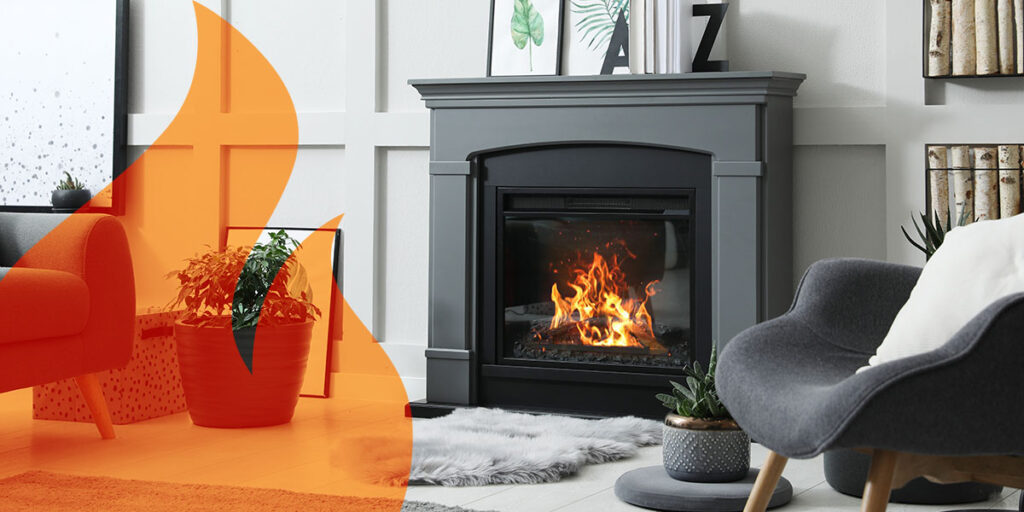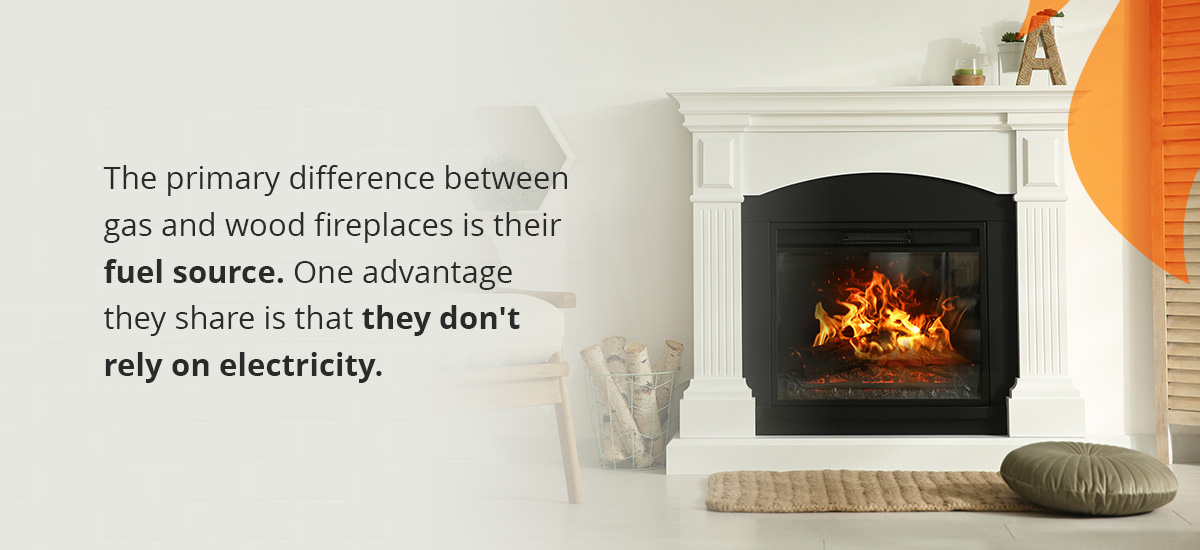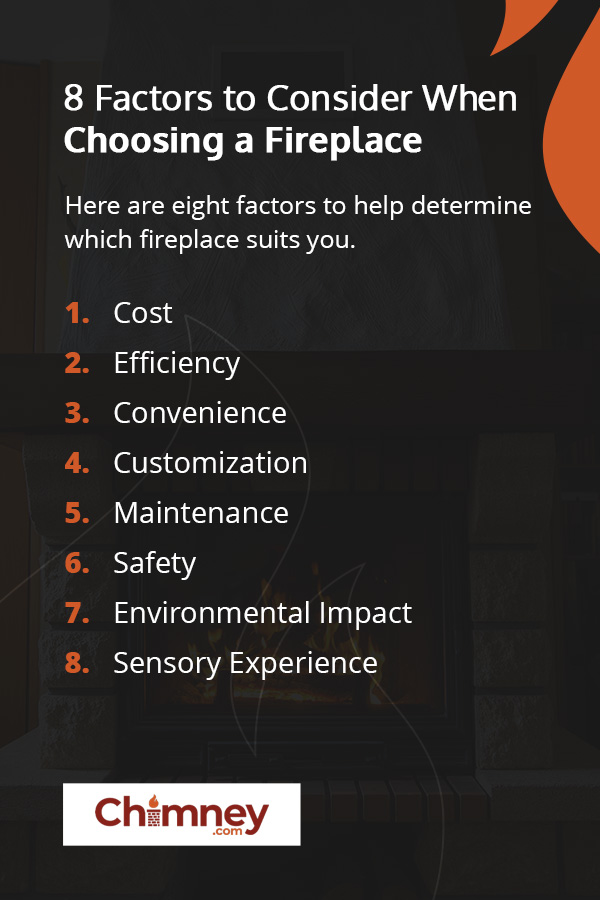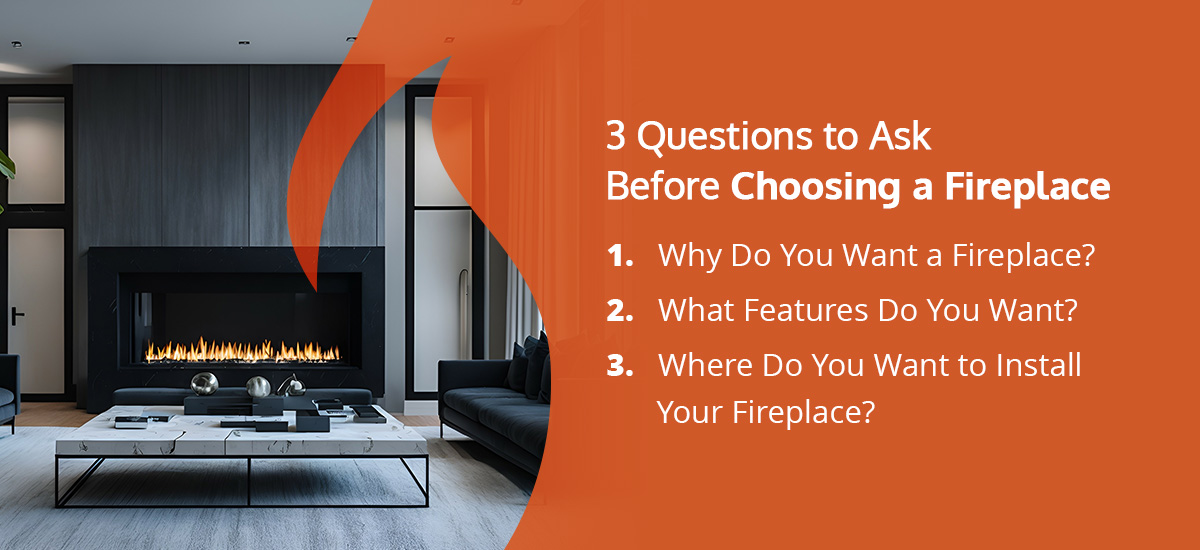Gas vs. Wood Fireplaces: A Buying Guide

07/06/23
The best place to be during winter is curled up next to a fireplace with a steaming cup of hot cocoa. You can snuggle under a blanket, watch the flickering flames, listen to the soothing crackles and pops and enjoy a good movie or book in a warm, relaxing environment.
On a pleasant summer evening, you can create an inviting and peaceful atmosphere by lighting your fireplace. You can gather your family and friends around it for an evening of games, movies and socialization without worrying about bugs or the fading light.
When imagining fireplaces, most people think of the classic wood-burning variety. But today’s homeowners can choose between gas, electric and wood-burning fireplaces for a traditional experience. Learn more about the benefits of a fireplace, the pros and cons of gas and wood and the various factors you should consider before purchasing one.
The Benefits of Fireplaces
You can install some fireplaces in virtually any room, thanks to modern technology. Regardless of where you install your fireplace, you reap numerous benefits.
- Increased resale value: Fireplaces attract more potential buyers and allow you to list your home for a higher price. A survey found that 77% of prospective buyers would pay more for a home with a fireplace.
- Lower energy bills: If you use your fireplace in the room you spend the most time in, you can decrease the thermostat for the rest of your house, thus reducing your energy bills. Additionally, you can use your fireplace to warm your room without turning on the heat, which is useful when it’s chilly but not cold enough to heat the whole house.
- Peaceful atmosphere: Fireplaces create a tranquil and relaxing atmosphere that can calm you physically and mentally.
- Design availability: There are many fireplace designs to choose from, so you can seamlessly integrate one into your home. The styles range from rustic to contemporary.

Gas vs. Wood Fireplace Pros and Cons
The primary difference between gas and wood fireplaces is their fuel source. One advantage they share is that they don’t rely on electricity. During a winter power outage, you and your family can light your fire and huddle around it to stay warm. Each fireplace type has different pros and cons.
Gas Fireplaces
Gas fireplaces are realistic alternatives to wood. They use natural gas or propane to fuel their flames. Most gas fireplaces have decorative imitation logs to replicate the look of wood fireplaces. You can choose a vented or ventless gas fireplace. Either way, the fire produces a flame.
Here are the leading advantages of gas fireplaces.
- Safer: Gas fireplaces are safer than wood because they don’t produce smoke, backdrafts or soot, or require matches or sparks to light them. Some gas fireplaces feature a glass panel that separates the firebox from the room.
- Greater convenience: One of the top gas fireplace benefits is that you can turn it on and off with a switch or remote and adjust the heat output.
- Customization options: These fireplaces offer more comprehensive customization options, including crystals, logs and rocks.
- Cleaner air: Since gas fireplaces don’t produce smoke, the air inside your home will stay fresher and cleaner.
- Less maintenance: Gas fireplaces require less maintenance than wood ones. You only need an annual inspection to ensure everything works correctly. You must also clean the glass occasionally.
- More efficient heating: Natural gas heats your space more quickly and efficiently than wood.
- Long-lasting: A gas fireplace can last many years with proper maintenance.
- Simple gas fireplace conversion: If your home already has a wood-burning fireplace, you can quickly convert it to gas for a lower cost.
Gas fireplace cons include the following.
- Less ambiance: A gas fireplace is warm and inviting, but can only partially capture a wood fireplace’s atmosphere. The sealed glass is a necessary safety feature that prevents you from feeling the heat on your skin, and a gas fireplace’s flame is typically smaller than a wood one.
- Higher operation costs: Gas fireplaces can cost more to operate than wood ones. For example, natural gas may be more expensive than wood in your region, or you might use your gas fireplace more frequently than a wood one.
- Nonrenewable fuel source: These fireplaces emit fewer emissions, but unlike wood, gas isn’t a renewable resource.
- Requires gas lines: Gas fireplaces need gas hookups to install. The installation will be more expensive if your home doesn’t have gas lines.
- Safety risks: Though gas fires are safer than wood ones, they still pose risks of spontaneous fires and carbon monoxide poisoning. Installing a CO2 detector reduces your risk of carbon monoxide poisoning, and monitoring your fireplace while it’s burning decreases your risk of accidental fires.
Wood Fireplaces
When envisioning a fireplace, you might picture a chimney with billowing smoke, coal and burning logs. A classic, traditional wood-burning fireplace uses logs as its fuel source to produce the look, sound and smell you know and love.
Wood fireplace pros include the following.
- Unparalleled ambiance: One of the most significant wood fireplace benefits is the atmosphere it creates. Nothing can match the look, feel and smell of an authentic fire.
- Various wood options: You can choose what type of wood you burn to make your fire long-burning, quick-burning or aromatic.
- Lower operation costs: Firewood is relatively inexpensive, unless you live in an area with limited wood. Still, it costs nothing but time to chop your own.
- Excellent heat production: Wood fireplaces produce plenty of heat to warm you and your family.
- Customization options: Wood fireplaces offer many classic and modern style and design options.
Wood fireplaces have a few potential drawbacks.
- Labor-intensive: You must add wood and stoke the fire to keep it going.
- Extra maintenance: Wood fires produce ash and soot, requiring regular cleaning. They also need annual inspections and routine chimney maintenance.
- Higher upfront costs: Wood fireplaces have higher upfront costs than gas ones, especially if you need a chimney.
- Less safe: You must monitor wood fireplaces, as they can be a fire hazard.
- Less energy-efficient: Burning wood uses more energy. Additionally, the chimney can create drafts that increase your utility bills.
8 Factors to Consider When Choosing a Fireplace

Gas and wood fireplaces heat and light a room while providing a space for connection and socialization. Both types can make you feel snug and content, which is why it can be challenging to choose between them. Here are eight factors to help determine which fireplace suits you.
1. Cost
When comparing gas vs. wood fireplace cost, you’ll find wood fireplaces are more expensive upfront but have potentially lower operating expenses. Various factors like installation requirements, labor and materials influence the total cost.
For instance, wood fireplaces require a chimney, while gas fireplaces require gas lines. Installing a gas fireplace anywhere in a room is easier since they don’t all need a chimney. If you already have a chimney, you can convert your wood fireplace to a gas one with an insert, which has a lower upfront cost. On average, you should expect to pay around $2,314 for your fireplace installation.
Gas fireplace operational costs depend on how frequently you use it and the availability of natural gas or propane in your region.
2. Efficiency
Gas vs. wood fireplace efficiency is a close call. Neither type requires electricity, so they help reduce your overall energy consumption. However, gas fireplaces contribute to your gas bill, while wood-burning ones don’t.
If you’re basing gas or wood fireplace efficiency on their ability to heat your home, gas fireplaces win. When you burn wood, more than 90% of the heat escapes through the chimney. However, one of the noteworthy differences between gas and wood fireplace inserts is that a wood insert prevents this heat loss by sealing the fireplace in a box.
When comparing gas vs. wood fireplace heat output, they both have high heat levels, but gas fireplaces lose less heat. Plus, you can adjust the output to suit your needs and save on fuel.
3. Convenience
Due to their fuel source, wood fireplaces are less convenient than their gas counterparts. You’ll have to buy or chop the wood, then position it in a specific way so the blaze takes hold. After starting the fire, you must continuously reposition the logs to keep it going. With a gas fire, all you do is flip a switch or press a button, sit back and watch it burn.
4. Customization
Gas and wood fireplaces have numerous customization options based on where you want your fireplace and what you intend to use it for. Gas fireplaces come in a wider range of shapes, sizes and styles. Plus, you can customize more of the minute details such as the log set, flame color, paneling and rock bed.
5. Maintenance
Gas units have vastly different cleaning and maintenance requirements than wood ones. Wood fireplaces produce ash, which you must clean after every use. Also, a professional must inspect and clean your chimney regularly. In contrast, you only have to dust a gas unit and hire a professional to clean and inspect it annually.
6. Safety
Without regular maintenance, a wood fireplace poses more of a safety hazard. If you don’t clean your fireplace after each use, ash and soot accumulate, increasing the chance of uncontrollable fires. In general, a gas fireplace is safer because most units have a glass door that seals the fireplace and prevents sparks from escaping.
7. Environmental Impact
Your fireplace’s environmental impact depends on how much you use it and whether you choose natural gas or propane. When debating the general environmental effects of gas and wood fireplaces, a wood-burning fireplace is less efficient and a bigger pollutant, since the smoke from the wood can decrease air quality. In contrast, gas fireplaces produce almost no emissions.
8. Sensory Experience
Natural wood fires offer an exceptional sensory experience. You can hear the crackling and pops of the burning logs, feel the heat on your skin, see the glow of the dancing flames and smell the forest as the fir, cedar or other wood burns.
Gas fireplaces produce a flame that mimics the look and feel of a wood fire. However, gas fires don’t create the popping sounds or woodsy scents of a traditional fire.
3 Questions to Ask Before Choosing a Fireplace
You might know which one you want after reviewing the differences between gas and wood fireplaces. But, if you still need clarification, ask yourself these three questions.
1. Why Do You Want a Fireplace?
Fireplaces serve two purposes — to heat your home and create a cheerful, calm atmosphere. Before selecting a fireplace, you must decide which of these benefits is a higher priority.
Gas is better than wood at heating your home. While both fireplaces set the mood, wood fireplaces have the classic smell and look. So, if you value ambiance over functionality, choose wood. For the best of both worlds, go with a gas fireplace.
2. What Features Do You Want?
Each fireplace type has different options and features. By knowing which ones are most crucial to your comfort, you can more easily choose between gas or wood.
- Venting: All wood fireplaces require a chimney to vent smoke. Some gas options require a chimney for venting gas, while others are ventless. Consider whether you want a chimney and if it’s within your budget.
- Controls: You create the flame for a wood-burning fireplace with matches, logs or kindling. A button or switch lights a gas fireplace in seconds.
- Decorations: Gas fireplaces can have fire-resistant decorations like pine cones, embers and fire glass.
3. Where Do You Want to Install Your Fireplace?
Gas fireplaces, especially vent-free ones, offer more installation flexibility. Here are some places where you can install your fireplace.
- Living room: The classic choice, a living room is a central gathering place that brings everyone together.
- Bedroom: You can place your fireplace in your bedroom to transform it into a private getaway with an added splash of luxury.
- Front and center: In open-concept floor plans, you can install your fireplace in the middle of your living, kitchen and dining room. It’ll become an attractive centerpiece.
- Dining room: Adding a fireplace to your dining room increases its opulence.
Trust the Experts at Chimney.com With Your Fireplace Needs
Whether you’re installing a brand-new fireplace or upgrading your old wood-burning one, you can trust the experts at Chimney.com to get the job done right. We use premium materials and complete projects promptly to ensure our clients receive the best service possible.
With over 30 years of experience, we’re your local, go-to chimney restoration, installation, maintenance and repair experts, serving customers in Maryland, Virginia and Washington, D.C. You can rest easy knowing your fireplace is the epitome of quality and luxury. Contact us today to learn more, schedule service or request a free installation quote.


